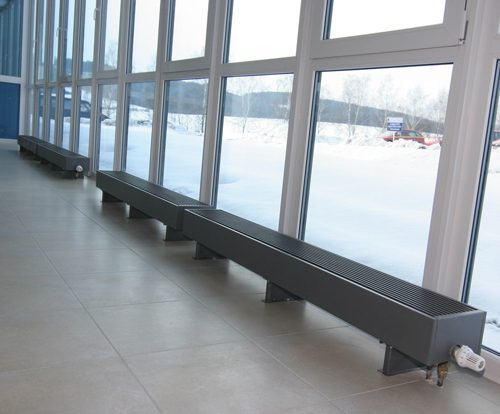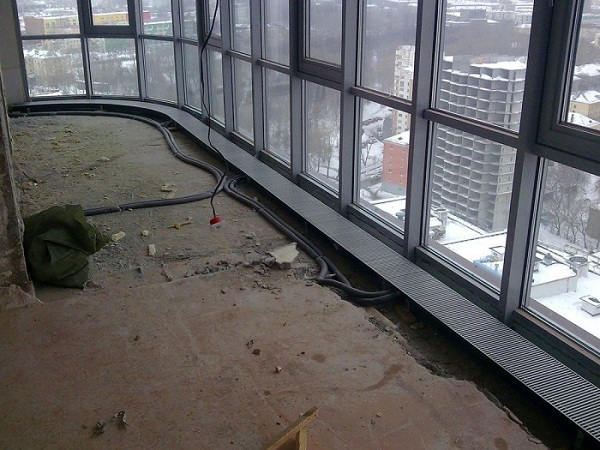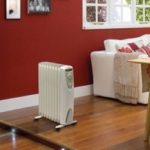How do electric floor convectors work?
Scientific research and practical application convincingly prove that outdoor electric convectors are very reliable sources of thermal energy. This progressive type of heating is successfully used in office, retail, industrial and in some residential areas. With their help, it is possible to achieve a uniform distribution of warm air throughout the room, while the energy loss is reduced to the minimum value.

Content
Principle of operation
The floor convector of heating appeared in our life quite recently, but in a very short time these products began to enjoy their well-deserved popularity among users.The simple design and versatility of use make these household appliances in demand in any human activity: at home and at work.
Floor convectors - these are heating devices, whose work is based on natural air circulation. The floor version has special legs, with which the device is located at a minimum height from the floor to ensure stable circulation of hot air from floor to ceiling. The main difference between such a device and a central heating battery is the original heat transfer method: the radiator heats the room with the help of thermal radiation, and the electric convector - due to circulation.
The efficiency of some devices of this type reach almost 95%.
In simple and understandable language: the air is directed to the convector, where it heats up and increases in volume according to the laws of physics, and then returns and rushes to the ceiling. New streams again go along the paved road - this is how the whole room is heated, because the colder air is discharged by warm streams to the floor, where it is sucked into the electric convector.

Types of equipment
Experts found three main types of convectors, which differ in the type of circulation:
- natural;
- forced;
- adapted.
Products of the first type work using natural air circulation, while compulsory ones use built-in fans. The second type works much more productively - convector with fan able to heat large rooms.
When humidity is present up to 98%, experts advise the use of floor convectors with an electric motor running on AC powerbecause they are less sensitive to humid climates. But here additional costs await you: the apparatuses with direct current consume 70% less energy than analogs of alternating current, therefore, the safety of such a heating system will have to be paid extra.

Where apply
Floor-type products are many times more economical than standard devices, so today they are used everywhere. The use of convectors for heating rooms with high ceilings and large areas is particularly effective: they generate more thermal energy in a certain period of time than their younger sister, a central heating battery.
Convectors do not have an alternative in rooms with glass doors, panoramic windows or for shopping centers with glazing in the form of a series of windows. When building office premises today, an embedded version of the convector is always used (for example, in the window sill), and the original protective grilles that run along the panoramic windows fit harmoniously into the modern interior without interfering with the business environment. At the entrance to a commercial bank you can meet such a convector built into the marble floor - peculiar thermal curtainprotecting the entire room from the penetration of cold air outside. There are also plinth options.

Design features
A distinctive feature of all convectors of this type - they have the form square box, whose length can be from 1 to 2 m. At the request of the customer, the shape of the case can be varied, therefore this device is organically suitable for any interior. From above, the designers have set decorative protective grilles - they are made of various materials, and the color scheme depends on the place of installation.

Inside the product case there is one or several heat exchangers - they are responsible for the transfer of heat from the circulating hot water to the heating of the room. The body of heat exchangers is made of non-ferrous metal with excellent thermal conductivity: aluminum, copper or brass. This significantly affects the final price of the entire product.
Housing floor heaters are made of stainless metal with high corrosion resistance. To connect to the central system are used corrugated pipes.
The nuances of the installation method are described in detail in the instructions from the company that manufactured the device.
Built into the case electric drivewhich drives a convector-type fan, the product is equipped with a transformer and a special thermal valve to increase efficiency.

Convector device
To understand all the nuances of the design of the convector, watch this video
Advantages and disadvantages
Outdoor devices have many positive qualities:
- resistance to mechanical damage - even the decorative grille can withstand loads of up to 40 kg;
- resistance to corrosion;
- simple and reliable operation;
- simple installation;
- the possibility of selecting the desired range of color solutions and the optimal shape of the body, depending on the surrounding interior;
- compact dimensions and low weight;
- uniform heating of the entire area;
- stable protection against overheating, possible burns;
- silent work.
Negative moments:
- the product attracts a lot of dust, because there is a constant circulation of air masses;
- these systems cannot work together with artificial ventilation;
- the presence of very high ceilings reduces work efficiency.
All modern floor convectors are equipped with built-in automatic needle-type air valves (popularly called the Mayevsky valve), which bleed air plugs.
Choose equipment
From the right choice of product depends on the functional efficiency of the heating system. Experts advise users to pay close attention to such nuances:
- type of heating system - autonomous or centralized;
- what temperature do you want to have;
- what temperature was previously in the room, before the installation of the convector;
- the product will be the main heater or in combination with a centralized heating system;
- the amount of heat from other types of heating, located nearby.
Special attention should be paid to the last item of this list: any appliances used in everyday life emit thermal energy, so its calculation must be done. At the same time you will significantly save when buying a convector.
If you have small children, then pay special attention to the decorative lattices - they should have such a frequency that the baby could not stick his finger there.
Floor-type products are the most efficient type of heating - they allow you to set the most comfortable climate for living.
Such equipment is popular due to stable security and high ergonomics, but you need to purchase products from famous manufacturerswhich have an impeccable reputation for many years and a guarantee on product quality.

Installation of equipment
Installation of floor convector heating should be carried out strictly according to the recommendations described in the accompanying instructions for use, especially when installing the option built into the floor. We start the installation work with a careful markup, the algorithm of all actions is well shown in this video
Pipe laying
When installing the system in a house under construction, all work ends before finishing work and filling floors. The convector is connected to the water supply with metal-braided hoses or pipes made of non-ferrous metal; separate connection from central heating.
Important! It is mandatory to install a valve that regulates the flow of coolant, and an automatic valve for bleeding air plugs.
When replacing a central heating radiator with a floor convector, we make the connection according to the previously established and existing scheme.
Level check
It is very important to install the product. strictly horizontal - for this it has adjustment bolts. This rule applies to all convectors - located on the floor or embedded in it. After installation and performance check, the final pouring and leveling of the floor begins: the edge of the product body should not protrude above the floor level. The last, after the final drying of the floor, is set decorative grille.

Care and maintenance
If you chose the convector correctly, then no outside financial investments will be required for its further operation and maintenance. Practice has established that for the quality work of such equipment it is necessary just maintain cleanliness - usually do wet cleaning.
In large office premises, where various instruments for copying and printing documents are constantly working, fine dust is a constant companion, so wet cleaning should be done before and at the end of the working day.

/rating_off.png)












